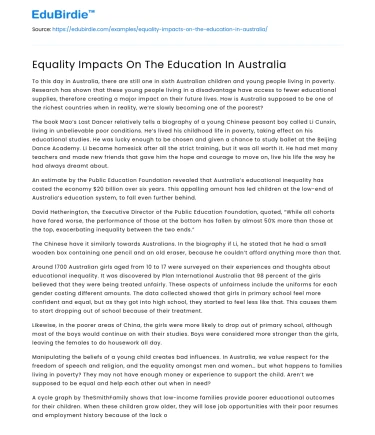To this day in Australia, there are still one in sixth Australian children and young people living in poverty. Research has shown that these young people living in a disadvantage have access to fewer educational supplies, therefore creating a major impact on their future lives. How is Australia supposed to be one of the richest countries when in reality, we’re slowly becoming one of the poorest?
The book Mao’s Last Dancer relatively tells a biography of a young Chinese peasant boy called Li Cunxin, living in unbelievable poor conditions. He’s lived his childhood life in poverty, taking effect on his educational studies. He was lucky enough to be chosen and given a chance to study ballet at the Beijing Dance Academy. Li became homesick after all the strict training, but it was all worth it. He had met many teachers and made new friends that gave him the hope and courage to move on, live his life the way he had always dreamt about.
Save your time!
We can take care of your essay
- Proper editing and formatting
- Free revision, title page, and bibliography
- Flexible prices and money-back guarantee
An estimate by the Public Education Foundation revealed that Australia’s educational inequality has costed the economy $20 billion over six years. This appalling amount has led children at the low-end of Australia’s education system, to fall even further behind.
David Hetherington, the Executive Director of the Public Education Foundation, quoted, “While all cohorts have fared worse, the performance of those at the bottom has fallen by almost 50% more than those at the top, exacerbating inequality between the two ends.”
The Chinese have it similarly towards Australians. In the biography if Li, he stated that he had a small wooden box containing one pencil and an old eraser, because he couldn’t afford anything more than that.
Around 1700 Australian girls aged from 10 to 17 were surveyed on their experiences and thoughts about educational inequality. It was discovered by Plan International Australia that 98 percent of the girls believed that they were being treated unfairly. These aspects of unfairness include the uniforms for each gender costing different amounts. The data collected showed that girls in primary school feel more confident and equal, but as they got into high school, they started to feel less like that. This causes them to start dropping out of school because of their treatment.
Likewise, in the poorer areas of China, the girls were more likely to drop out of primary school, although most of the boys would continue on with their studies. Boys were considered more stronger than the girls, leaving the females to do housework all day.
Manipulating the beliefs of a young child creates bad influences. In Australia, we value respect for the freedom of speech and religion, and the equality amongst men and women… but what happens to families living in poverty? They may not have enough money or experience to support the child. Aren’t we supposed to be equal and help each other out when in need?
A cycle graph by TheSmithFamily shows that low-income families provide poorer educational outcomes for their children. When these children grow older, they will lose job opportunities with their poor resumes and employment history because of the lack of education. In the end, it resolves in impoverished life outcomes like money.
In the book Mao’s Last Dancer, Li was forced by the provided education that Chairman Mao (Chairman of the Communist party of China) was the greatest leader of all time and that China was the richest country Li could ever live in.
When Li travelled to America for 6 weeks to spread Chinese Communism. He asked himself, “All I thought of those dark, scary images of capitalist society… China’s most hated enemy… What should I believe? What communism had taught me? Or what I’d seen and experienced? Why had Chairman Mao, Madame Mao and the Chinese government told its people all those lies about America?” This proved that back then, Chinese
Communism was top priority in their country. They manipulated Li’s thoughts into thinking that America’s Capitalism “so bad” that even his parents were worried sick about him and the foreigners there.
In the end, I personally believe that the Australian government should have lower priced educational systems for younger children (i.e. primary schools and kindergartens). This way, younger children who are living in poverty can have a chance at living a better future with better education. What are the chances that if this change were to be made, Australia would have an increase in the economy system through the next years?
Bibliography
- Hetherington, D. (2018). CEDA - Education inequality is costing Australia billions. Retrieved 13 November 2019, from https://www.ceda.com.au/Digital-hub/Blogs/CEDA-Blog/April-2018/Education-inequality-is-costing-Australia-billions#:~:targetText=Educational%20inequality%20in%20Australia%20is,move%20through%20their%20school%20years
- Up to 98 per cent of Australian girls feel gender inequality, survey suggests. (2017). Retrieved 13 November 2019, from https://www.sbs.com.au/news/up-to-98-per-cent-of-australian-girls-feel-gender-inequality-survey-suggests
- Cobbold, T. (2018). Australia’s Education System is Nearly the Most Unequal in the Developed World – SOS Australia. Retrieved 13 November 2019, from http://saveourschools.com.au/equity-in-education/nearly-the-most-unequal-in-the-developed-world/
- Poverty in Australia | The Smith Family Australia. (2019). Retrieved 13 November 2019, from https://www.thesmithfamily.com.au/poverty-in-australia
- Remeikis, A. (2019). Educational inequality widening Australia’s rich-poor gap, report finds. Retrieved 13 November 2019, from https://www.theguardian.com/australia-news/2018/apr/03/educational-inequality-widening-australias-rich-poor-gap-report-finds






 Stuck on your essay?
Stuck on your essay?

